Apple 15-inch MacBook Pro (Late 2011) Review
by Anand Lal Shimpi on November 17, 2011 5:10 PM EST- Posted in
- Mac
- Apple
- Intel
- MacBook Pro
- Sandy Bridge
- Laptops
The early 2011 MacBook Pro is honestly Apple's best effort to date. Only using quad-core CPUs on the 15 and 17-inch models, and offering an optional Thunderbolt Display that can act as a modern day dock makes this platform, particularly the 15-inch model, the perfect candidate for users who want the power and flexibility of a desktop with the portability of a notebook. Apple gets the mobile revolution in more ways than one, and its MacBook Pro/Thunderbolt Display combo is the perfect example of that.
It's this very combination that I've been using, partially since the introduction of the Sandy Bridge MacBook Pro earlier this year (the Thunderbolt Display didn't arrive until later). I've been quite happy with the setup. With the exception of lackluster Quick Sync adoption by Apple and obviously limited GPU options, I have very few major complaints.
Late last month, Apple updated its 2011 MacBook Pro lineup - likely the first and last update before Apple adopts Ivy Bridge in Q2 next year. We got our hands on the new base 15-inch MacBook Pro configuration, which received one of the more substantial upgrades over the previous model. As this is still a fairly minor upgrade, be sure to read our original review of the platform for a deeper dive into all of the aspects of the system.
| Late 2011 MacBook Pro Lineup | |||||||
| 13-inch (low end) | 13-inch (high end) | 15-inch (low end) | 15-inch (high end) | 17-inch | |||
| Dimensions |
0.95 H x 12.78 W x 8.94 D
|
0.95 H x 14.35 W x 9.82 D
|
0.98 H x 15.47 W x 10.51 D
|
||||
| Weight |
4.5 lbs (2.04 kg)
|
5.6 lbs (2.54 kg)
|
6.6 lbs (2.99 kg)
|
||||
| CPU |
2.4 GHz dual-core Core i5
|
2.8 GHz dual-core Core i7
|
2.2 GHz quad-core Core i7
|
2.4 GHz quad-core Core i7
|
2.4 GHz quad-core Core i7
|
||
| GPU |
Intel HD 3000 Graphics
|
Intel HD 3000 + AMD Radeon HD 6750M (512MB)
|
Intel HD 3000 + AMD Radeon HD 6770M (1GB)
|
Intel HD 3000 + AMD Radeon HD 6770M (1GB)
|
|||
| RAM |
4GB 1333MHz DDR3 (8GB max)
|
||||||
| HDD |
500GB 5400 RPM
|
750GB 5400 RPM
|
500GB 5400 RPM
|
750GB 5400 RPM
|
750GB 5400 RPM
|
||
| Display Resolution |
1280x800
|
1440x900 (1680x1050 optional)
|
1920x1200
|
||||
| Ports |
Gigabit LAN, Firewire 800, Thunderbolt, 2x USB 2.0, SDHC slot, combined audio in/out jack
|
Gigabit LAN, Firewire 800, Thunderbolt, 2x USB 2.0, SDHC slot, separate audio in/out jacks
|
Gigabit LAN, Firewire 800, Thunderbolt, 3x USB 2.0, separate audio in/out jacks, ExpressCard 34 slot
|
||||
| Battery Capacity |
63.5Wh
|
77.5Wh
|
95Wh
|
||||
| Price | $1,199 | $1,499 | $1,799 | $2,199 | $2,499 | ||
Silicon Updates
The focus of Apple's late 2011 update, despite rumors to the contrary, was on the silicon inside the platform. As the Mac business is a relatively mature one, we can expect a slower pace of chassis and design upgrades compared to the iPhone/iPad businesses for example.
We'll start with the CPU, the lesser updated chip in the new MacBook Pro. System pricing hasn't changed, but CPU speeds have all gone up.
Just as before the 15-inch MacBook Pro is only available with a quad-core Intel Core i7 CPU (codename Sandy Bridge). The $1799 configuration goes from a 2.0GHz i7 to a 2.2GHz model. Be warned, this isn't the same 2.2GHz model that was available as an upgrade earlier this year though.
A quick run of Cinebench points out that the 2.2GHz i7 in our system may be a Core i7 2675QM. The original 2.2GHz option was a Core i7 2720QM. What's the difference between the two? Not a whole lot.

Max turbo is down a bit on the 2675QM. It was 3.3GHz on the 2720, but now it's 3.1GHz. The two, three and four core turbo limits are also down by 200MHz compared to what they were in early 2011. If you didn't have a 2.2GHz early 2011 15-inch MacBook Pro, these differences likely don't mean anything. If for whatever reason you're comparing to an early 2011 2.2GHz model, you'll see a slight regression in CPU bound performance.
The on-die GPU is a hair slower as well. You still get an Intel HD 3000 GPU (12 EUs) but the max turbo moves from 1.3GHz down to 1.2GHz. Or if you prefer another way of looking at it, the 2675QM is the same as the 2670QM, except the GPU is able to clock 100MHz higher (1.2GHz vs. 1.1GHz).
| Apple 15-inch Late 2011 MacBook Pro CPU Comparison | |||||
| 2.2GHz quad-core | 2.4GHz quad-core | 2.5GHz quad-core | |||
| Intel Model | Core i7-2675QM | Intel Core i7-2760QM | Intel Core i7-2860QM | ||
| Base Clock Speed | 2.2GHz | 2.4GHz | 2.4GHz | ||
| Max SC Turbo | 3.1GHz | 3.5GHz | 3.6GHz | ||
| Max DC Turbo | 3.0GHz | 3.4GHz | 3.5GHz | ||
| Max QC Turbo | 2.8GHz | 3.2GHz | 3.3GHz | ||
| L3 Cache | 6MB | 6MB | 8MB | ||
| AES-NI | Yes | Yes | Yes | ||
| VT-x | Yes | Yes | Yes | ||
| VT-d | No | Yes | Yes | ||
| TDP | 45W | 45W | 45W | ||
The upgraded 15-inch configuration comes with an all new Sandy Bridge SKU: the Core i7 2760QM running at 2.4GHz. Unlike the old 2.3GHz part, the 2760QM still only has a 6MB L3 cache. You do get higher base and turbo speeds. There's also a new 2.5GHz quad-core option that can run at up to 3.6GHz with a single core active. That's an absolutely insane frequency for a notebook. Notebook-as-a-desktop users will appreciate the flexibility here.
All of the new CPUs support AES-NI, although once again Apple is the victim of Intel's silly segmentation. The entry level 2.2GHz part does not support VT-d (Virtualization Technology for Directed I/O), which allows virtual machines to have direct access to I/O devices (including PCIe GPUs). I'm not sure if any current virtualization software for OS X supports VT-d, but the absence of the feature is important to note nonetheless. The rest of the CPU lineup supports VT-d.

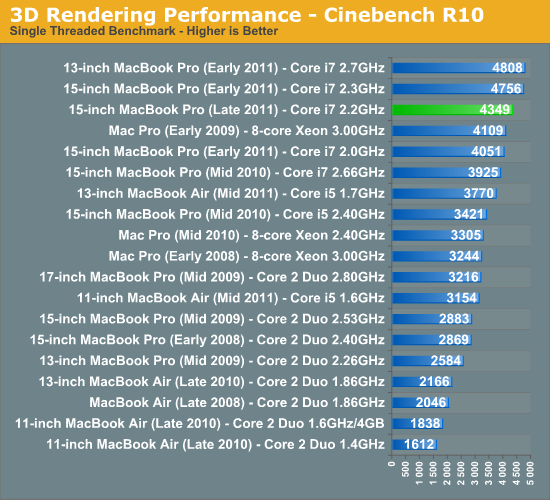
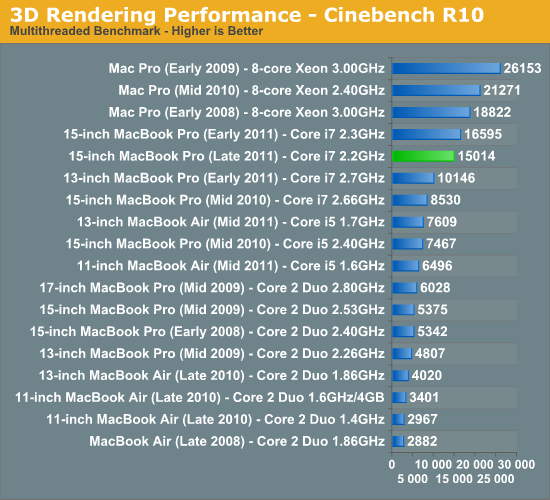
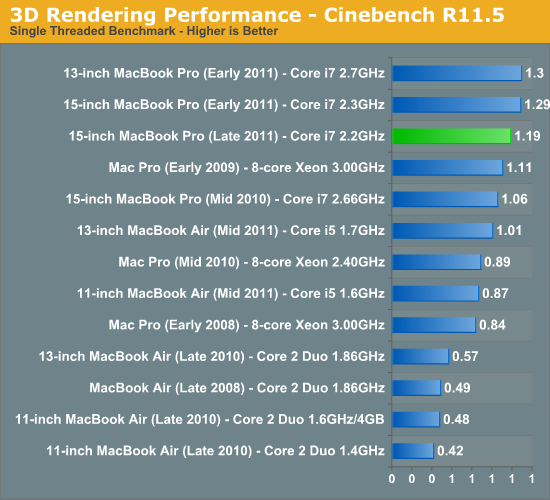
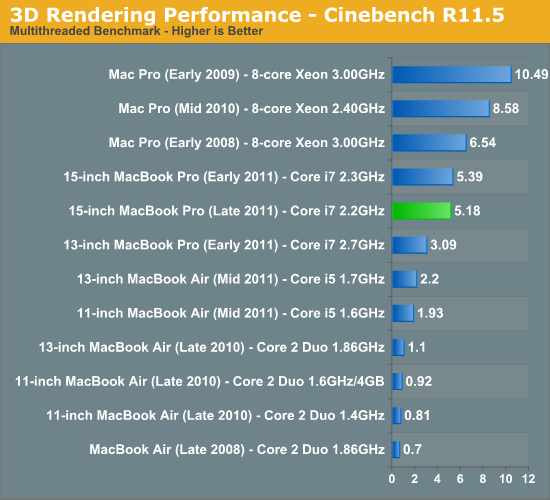
Battery Life
TDPs haven't changed, nor has the MacBook Pro's battery capacity, so overall battery life should (and does) remain relatively unchanged from the early 2011 models. Worst case scenario you can expect around 2.5 hours of battery life under load. With moderate load expect 4 - 5 hours of use on a single charge. And under a very light load you can easily exceed 7 hours.
I ran our normal battery life suite, however Lion has made some of the numbers a little less comparable than I would've liked. The lighter use cases (e.g. our web browsing tests) see a drop compared to our older Snow Leopard results. Under full load the new platform, even while running Lion, actually did a bit better than its predecessor. All in all I'd say the new MacBook Pro is pretty consistent with its predecessor - Lion just threw a wrench in a lot of our battery life comparisons so we'll be starting over from scratch in building our new database.
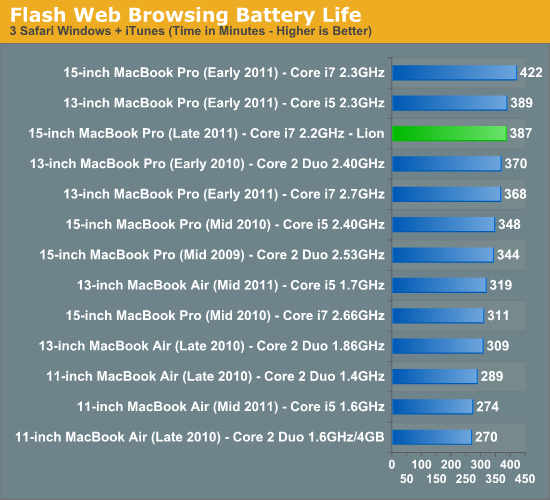
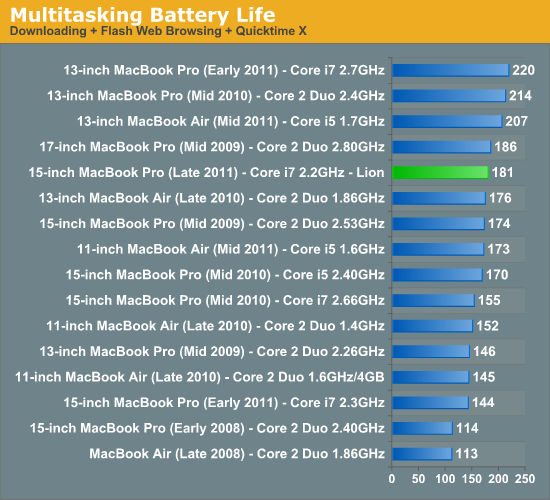


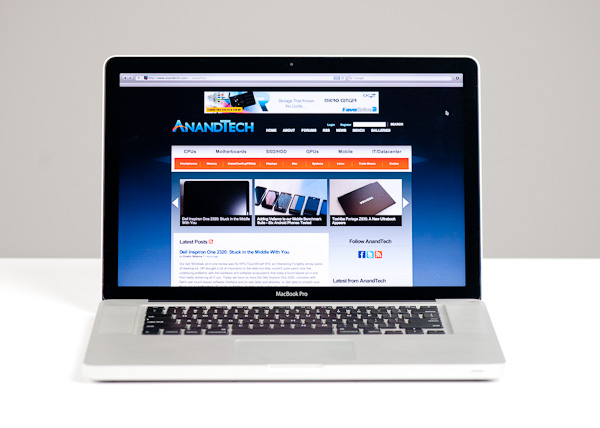
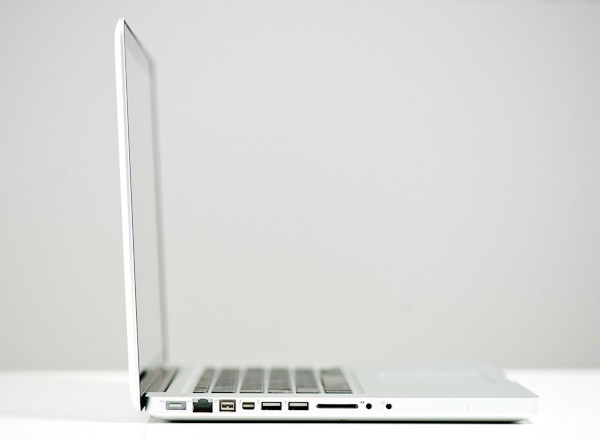
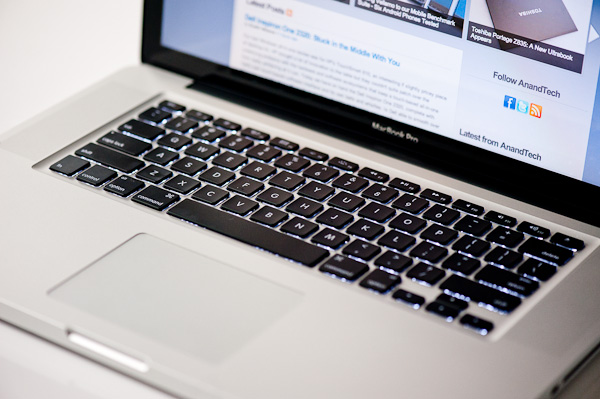








101 Comments
View All Comments
JarredWalton - Thursday, November 17, 2011 - link
Three things: brand name, build quality, and LCD quality. While I can easily ignore the first, the second two are an area where Apple consistently gets it right. I wish Dell, HP, etc. would do better at copying the important aspects of the MacBook Pro rather than just a stab at aesthetics, because as much as I like the 15z it's definitely not put together anywhere near as well as the MBP 15.maxxl - Thursday, November 17, 2011 - link
Although you must realize that there are lots of "retrospooty" thinking people around, which are always moaning. And no matter what you will say, this retrospooty's kind of people wil always try to convince you, that you are looser, becouse they can buy "dozens of tables for a price of an iPad". I say to them: stop moaning, just go buy what you want, I'm not interested in your opinion ;)zhill - Thursday, November 17, 2011 - link
Yeah, I agree Jarred. Plus don't forget OS. I'm convinced that if Apple stopped making OS X and just had Windows on their hardware they wouldn't sell nearly as many machines. OS X isn't all great, but it is significantly different than Windows and the whole "you won't get viruses on a Mac" argument is a big seller (I'm not going to argue it is actually more secure, but the market-share argument is reasonable enough, although in that case Apple is its own worst enemy--more market share=more likely for attack).Plus, Apple's interface items are so much better than most PCs: keyboard (generally speaking, but there are some good PC keyboards..uhem Thinkpad which I'm typing this on...though they aren't cheaper); the trackpad is vastly superior to the windows equivalents in terms of multitouch and precision--still love my Trackpoint nub though :)
maxxl - Thursday, November 17, 2011 - link
So what? Do you really think that there is someone interested in your buying decisions? Do you really think that Apple will lower their prices, becouse only that will drive mr. retrospooty to buy one MB Pro, which he cries for? Stop moaning, just buy what you can afford. I don't give sh.t what laptop you will choose. Good luck, be happy "equivalent ones" boy... ROTFL ;))))iSayuSay - Friday, November 18, 2011 - link
Really? You can get 2 laptop with nice equivalent keyboard, trackpad, display, tech support, aluminum unibody for $1800?Wow .. where did you get that? Please share your valuable information with us. Does it come with OSX too?
vision33r - Thursday, November 17, 2011 - link
There's no way Dell, Asus, or HP will ever get close to Apple in terms of build quality. It's simply unprofitable as it is in the PC industry with cut throat competition and lower margins.Most Windows users can accept shoddy quality as long as things are cheap and they can upgrade every other year.
KoolAidMan1 - Thursday, November 17, 2011 - link
Unfortunately this is why they'll keep being inferior. It sucks because you see some trying to do what the MBP does but it is only on the most superficial level, they completely miss the point when it comes to the displays and trackpads.ananduser - Friday, November 18, 2011 - link
Have you personally tested all high end solutions from other manufacturers than your favorite brand, KoolAid drinking man(says so in your nick) ? I think not. Defending your reasons for your acquisition does not a best laptop make.Greg512 - Friday, November 18, 2011 - link
I read a lot of reviews and have yet to see a PC with the combination of processing power, screen quality, keyboard/touchpad quality, and battery life that the MacBook Pro 15 in. has. One may exist, but I haven't seen a review of it. I am not saying Macs are perfect, but they do other a combination of features and quality that are quite rare. I am not a fan of OSX, but I do like Apple hardware.KoolAidMan1 - Friday, November 18, 2011 - link
Show me a laptop with the same combination of size, performance, display quality, keyboard, battery life, and trackpad.I've looked at my share, and the only one I'd consider at this point is a mid to high range Lenovo, vetted to get a good display since many of them have poor ones. The x220 with the IPS upgrade is quite good, despite the 16:9 display.
Most laptops aren't very good, and it is completely the fault of companies for missing the point and copying the MBP on only the most superficial level with case design.